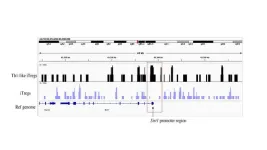(Press-News.org) *Please mention the European Congress of Clinical Microbiology and Infectious Diseases (ECCMID 2024, Barcelona, 27-30 April) if using this material*
A new research review to be given at a pre-congress day for this year’s European Congress of Clinical Microbiology and Infectious Diseases (ECCMID 2024) will highlight the potential artificial intelligence (AI) has to improve the speed and accuracy of investigations into infectious disease outbreaks in hospitals, and potentially provide real time information to stop or prevent them. The talk will be by Dr Jonas Marschall, Division of Infectious Diseases, Washington University School of Medicine, St. Louis, MO, USA.
Dr Marschall uses the example of an outbreak of vancomycin-resistant Enterococcus faecium (VRE) that began in late 2017, in Bern University Hospital, Switzerland and went on until July 2020, receiving substantial media attention and becoming Switzerland’s largest-ever multidrug-resistant organism outbreak.
The investigations into the outbreak revealed most VRE affected patients were colonised and not infected (a “silent outbreak”); that isolation of VRE patients was costly (requiring isolation rooms, personal protective equipment and bed closures); and that screening for VRE required a substantial logistical and financial effort (screening were proximity-based, captured entire floors, or were even hospital-wide).
Dr Marschall and colleagues then re-analysed the medical records generated during the first two years of the outbreak period (1/2018-12/2019) and identified (and mostly confirmed) risk factors for VRE colonisation by using various statistical methods and then moved to a framework called network graph theory and graph neural networks (a type of AI).
Briefly, network graphs inspect the connections between discrete “nodes” in a network (which could be patients, rooms, devices) and determines, for example, which nodes are most connected or which nodes have the shortest path to another node (and thus play a larger role in the outbreak).
Dr Marschall explains: “The more traditional methods for analysing outbreaks might yield signals that tend to confirm previously known and often generic risk factors, without adding the detail needed to make specific interventions”.
Extrapolating from their preliminary work in the field, Dr Marschall thinks AI-based analyses could ultimately provide answers to key questions in an outbreak – for example, their study (click on link above for full article) showed that the “electrocardiography service” and the “examination room ZZ” were at the centre of many interactions, and thus could likely have served as a place of transmission – in consequence, that room/device/person could be the target for disinfection/interventions.
However, in this study, Dr Marschall explains that not all employee interactions were captured because not every profession logs their time with a patient as well as, for example, nursing personnel do (which leaves gaps in our understanding of the many interactions happening in an acute care hospital). To extract the maximum of information, all interactions between patients, employees, visitors, rooms, and devices would have to be captured. Also, Dr Marschall and colleagues based their work on the local data infrastructure in Bern – while the general approach they describe can be used for any setting, a given hospital would need to ensure its data is in an analysable format and labeled so as to facilitate interpretation.
To make AI input into infectious disease outbreaks a success, Dr Marschall explains that hospital teams must pivot from research to operations, meaning implementing and refining AI tools as an outbreak happens in real time (which is not easy to predict), He explains “this approach could even help with individual patients infected with a multidrug-resistant organism or small clusters of such patients because it could identify surrounding patients/employees and rooms/devices that would need to addressed, either by screening or by targeted disinfection. The beauty of AI in outbreak management (and where its greatest power lies) is to make real time or near real time operational decisions easier, quicker and more precise.”
In his talk, Dr Marschall highlights that novel approaches to medical data (such as network graphs and temporal graph neural networks) can provide us with the framework to elevate outbreak investigations to the next stage. It can identify specific "hot spots" of an outbreak, where transmissions are likely to happen, and give us the tools to target these hot spots in order to fight an outbreak. He concludes: “If this help comes to infection prevention experts in near real time, it will dramatically improve their ability to respond to an outbreak.”
END
How artificial intelligence could improve speed and accuracy of response to infectious disease outbreaks in hospitals, and even prevent them
2024-02-28
ELSE PRESS RELEASES FROM THIS DATE:
Walleye struggle with changes to timing of spring thaw
2024-02-27
Walleye are one of the most sought-after species in freshwater sportfishing, a delicacy on Midwestern menus and a critically important part of the culture of many Indigenous communities. They are also struggling to survive in the warming waters of the Midwestern United States and Canada.
According to a new study published Feb. 26 in the journal Limnology and Oceanography Letters, part of the problem is that walleye are creatures of habit, and the seasons — especially winter — are changing so fast that this iconic species of freshwater fish can’t keep up.
The timing of walleye spawning ...
New UC Berkeley-led study reveals widen gap on racial inequality in higher education
2024-02-27
A UC Berkeley-led study revealed that disparities in the share of Black and Latino students admitted to America’s elite colleges and universities have endured and even widened over the last 40 years.
The study, "Shifting Tides: The Evolution of Racial Inequality in Higher Education from the 1980s through the 2010s,"(link is external) was published this month in Sage Journals and conducted by a team of researchers from UC Berkeley’s Social Sciences D-Lab, SUNY Polytechnic Institute, University of Arizona and Portland State University. It used four national survey datasets to examine college attendance trends across ...
New study links placental oxygen levels to fetal brain development
2024-02-27
A new study shows oxygenation levels in the placenta, formed during the last three months of fetal development, are an important predictor of cortical growth (development of the outermost layer of the brain or cerebral cortex) and is likely a predictor of childhood cognition and behaviour.
“Many factors can disrupt healthy brain development in utero, and this study demonstrates the placenta is a crucial mediator between maternal health and fetal brain health,” said Emma Duerden, Canada Research Chair in Neuroscience & Learning Disorders ...
Long-term survivors of childhood cancer at higher risk of death following heart issues; threshold for treating risk factors should be lower
2024-02-27
New research out of VCU Massey Comprehensive Cancer Center and VCU Health Pauley Heart Center indicates that survivors of childhood cancer are at a significantly higher risk of death following a major cardiovascular event — including heart failure, heart attack or stroke — than the general public.
The findings – published this week in the Journal of the American College of Cardiology — could fuel advocacy for a paradigm shift in clinical heart health guidelines to address cardiovascular risk factors at an earlier age in childhood cancer survivors.
“We found that the risk of death after a major cardiovascular event in a 50-year-old in the general population ...
Study finds pesticide use linked to Parkinson’s in rocky mountain, great plains region
2024-02-27
EMBARGOED FOR RELEASE UNTIL 4 P.M. ET, TUESDAY, FEBRUARY 27, 2024
MINNEAPOLIS – Pesticides and herbicides used in farming have been linked to Parkinson’s disease in the Rocky Mountain and Great Plains region of the country, according to a preliminary study released today, February 27, 2024, that will be presented at the American Academy of Neurology’s 76th Annual Meeting taking place April 13–18, 2024, in person in Denver and online.
“We used geographic methods to examine the rates ...
Researchers make precious headway into a genetic form of Alzheimer’s disease
2024-02-27
(Santa Barbara, Calif.) — UC Santa Barbara researchers and collaborators in Colombia, Brazil and Germany are progressing toward an understanding of mechanisms that underlie Alzheimer’s disease, in particular an early-onset, genetic form that has afflicted generations of an extended family in Colombia. They also shed some light on a woman from that family who managed to beat the odds.
“What are the chances,” said UCSB neuroscientist Kenneth S. Kosik, a senior author of a paper that appears in the journal Neuron. “It’s unbelievable serendipity.”
It all takes place in the ...
CBD shown to ease anxiety without the risks that can come with THC
2024-02-27
Cannabis products high in the nonintoxicating compound CBD can quell anxiety better than THC-dominant products— and without the potential side effects, new University of Colorado Boulder research suggests.
The study of 300 people, published in the journal Cannabis and Cannabinoid Research, is the first randomized trial to examine how legal, commercially available cannabis impacts anxiety symptoms.
The study comes as one in five U.S. adults suffer from an anxiety disorder, making it the most common mental illness in the country, and prescriptions for anti-anxiety medications are on the rise.
“We ...
Sniffing our way to better health
2024-02-27
RIVERSIDE, Calif. -- Imagine if we could inhale scents that delay the onset of cancer, inflammation, or neurodegenerative disease. Researchers at the University of California, Riverside, are poised to bring this futuristic technology closer to reality.
In lab experiments, a team led by Anandasankar Ray, a professor of molecular, cell and systems biology, exposed the fruit fly (Drosophila melanogaster) to diacetyl, a microbial volatile compound released by yeast, and found changes in gene expression in the fly’s antennae in just a few days. In separate experiments, ...
Texas Tech and TTUHSC professors honored as NAI senior members
2024-02-27
The National Academy of Inventors (NAI) has announced four faculty members from the Texas Tech University System as part of the 2024 class of Senior Members.
Noureddine Abidi and Seshadri Ramkumar, both professors at Texas Tech University; Annelise Nguyen, associate dean for research at the School of Veterinary Medicine in Amarillo; and Hongjun (Henry) Liang, a professor from Texas Tech University Health Sciences Center (TTUHSC), join 120 other emerging academic inventors in this year’s class.
“These individuals are great representatives of the innovative spirit here at Texas Tech and are highly deserving of this recognition,” ...
UMass Amherst researchers identify enzyme key to training cells to fight autoimmune disorders
2024-02-27
Februay 27, 2024
UMass Amherst Researchers ID Enzyme Key to Training Cells to Fight Autoimmune Disorders
Discovery of new signaling pathway in immune cells may lay the foundation for drug-free, side-effect-free treatments for patients with aplastic anemia and other autoimmune disorders
AMHERST, Mass. – Researchers at the University of Massachusetts Amherst recently released a first-of-its-kind study that focuses on the rare autoimmune disorder aplastic anemia to understand how a subset of cells might be trained to correct the overzealous immune response that can lead to fatal autoimmune disorders. The research, published in Frontiers in Immunology, ...




